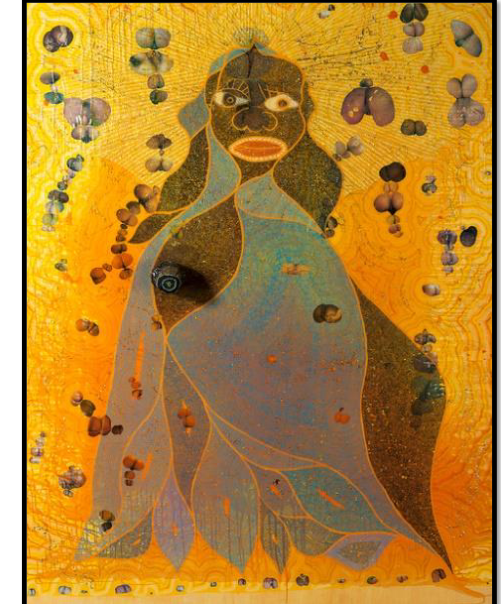
Chris Ofili’s “Holy Virgin Mary” artwork was created in 1996. It uses several media at once, comprising oil paint, paper collage, polyester resin, glitter, elephant dung, and map pins on linen. The image is of a black Virgin Mary, wearing a blue cape that covers her head to toe. A cape has an open space, which shows her right breast made of a dried elephant dung lump. The woman is standing in the middle on the yellow-orange locale with swirly lines that adds a little bit of variety to the environment. The collaged pictures of the female genitalia of a woman are cut from the porn collages and arranged all around the portrait (Von Veh 362). An overlapping technique is used to make sure some of these collages are atop of the others and, thus, seem visually closer to a viewer. Through the use of one of the most archetypical images of a woman in Western culture – that of the Virgin Mary – the painting discusses the questions of universal femininity. As mentioned above, a black woman represented as the Virgin Mary is enclosed by the genitalia of female prostitutes and elephant dung, thus, deliberately contrasting sacred and profane (Miller 4). By doing so, Ofili’s painting contrasts the sanctified aspect of femininity, as represented by the Virgin Mary, and its pronouncedly mundane aspect, as represented by the porn industry. The overstated African facial features also draw attention to racial stereotypes and the assumption of biblical figures’ whiteness in Western illustrations (Von Veh 364). Overall, the painting stresses that femininity remains essentially the same and equally worthy of respect regardless of race or social prejudice. Chris Ofili’s artwork is conflicting, and most of the conservatives who had examined it posited that the artwork is offensive. It was irritating not only to the Catholics because of its lack of reverence but also, in some respects, to the public as a whole. Dennis Heiner attempted to deface the image because of the inclusion of collaged pornography and real shit that could be enough to offend conservative religious viewers (Miller 3). Conservative critics ridiculed the portrait as being emblematic and blasphemous to Christianity. Moreover, the artist shocked the world by applying elephant dung to his painting (Von Veh 367). Many people believed Chris Ofili offended religious viewers because he represented “The Holy Virgin Mary” as a black mother of Jesus Christ. Rudy Giuliani threatened to cut the funding of the Brooklyn Museum of Art building and remove the portrait from the building because it was anti-catholic (Miller 1). However, to understand Chris Ofili’s painting complexity, one should look beneath the surface, where a message of respect rather desecration can be found.
Works Cited
Miller, J. H. “Controversial ‘hip-hop Version’ of the Virgin Mary Given to MoMA.” The Art Newspaper – International Art News and Events, Web.
Von Veh, Karen. “The Role of Beauty and Perfection in Marian Iconography: Contemporary Responses to Controversial Images of Virgin Mary by Chris Ofili and Diane Victor.” IKON, vol. 10, 2017, pp. 359-368.